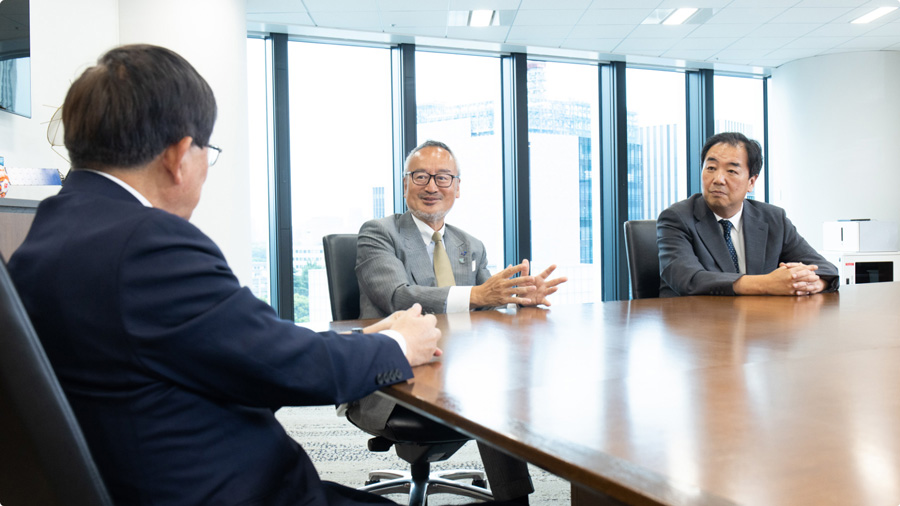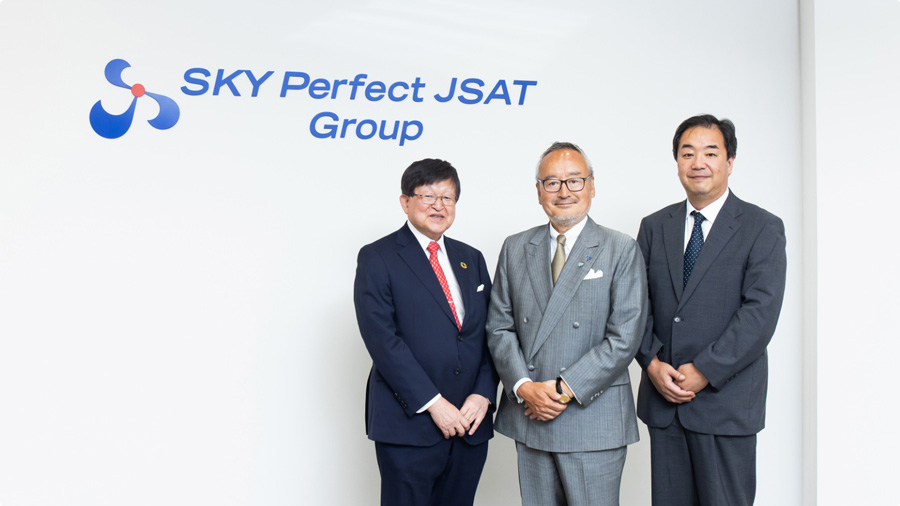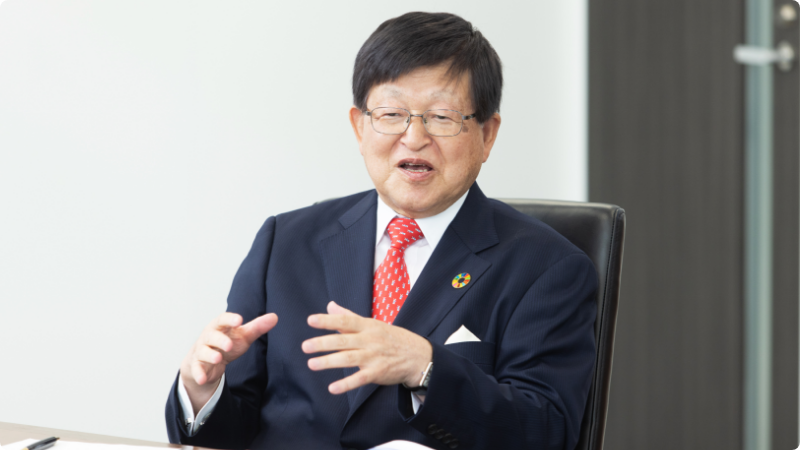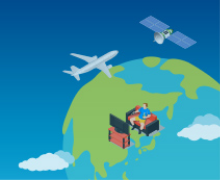- Sustainability
- Materiality
- Dialogue with Expert
FY2023: Dialogue with Expert (Overall Sustainability)
Materialities should be tied to the SDGs,
and departments and employees should take
ownership of them
June 6, 2023
Introduction of Participants
![]()
Mr. Hidemitsu Sasaya
CSR/SDGs Consultant Professor, Chiba University of Commerce
See bottom of page for detailed profile.
![]()
Eiichi Yonekura
Representative Director, President
![]()
Koichi Matsutani
Sustainability Committee Chair,
Director
※Positions are as of June 2023
Although the SDGs are goals,
we must also use them as tools at the target level
and take ownership
In this year’s review of materialities, the information is organized into an ESG/SDGs Matrix which shows the relationship between materialities and ESG/SDGs. The SDGs are linked to business activities at the target level. This makes it possible to link the KPI (Key Performance Indicators) of departments and employees to the SDGs, which are the world’s common language. The matrix can appeal to investors and be a powerful tool for improving corporate value. For employees too, motivation increases as they become aware of the need to achieve the SDG targets. How is the situation at the SKY Perfect JSAT Group?
I feel that we have created opportunities to report on our SDG targets on a regular basis and that we have been able to bring them down to the departmental level. However, SDG targets have not yet reached the level of the team, which is our lowest-level organization. Since these targets were not originally created on-site, employees have not been able to take ownership. We must devise a mechanism that can be executed as a basic action by each segment, and ultimately each team, without feeling like they are being forced to do it.
When the SDGs were first created, I learned from a UN official that “the SDGs are goals, but they are also tools.” From that perspective, many companies in Japan and around the world utilize the SDGs, but there are still very few companies that are fully utilizing them to the target level. When a company masters the SDGs to the target level, the employees take ownership of them. At many of the companies I’ve helped, the SDGs are tied to departments, making it easier for employees to take ownership of them.
In the Space Business, which is primarily a B-to-B business, our users who are focused on decarbonization have high expectations from the perspective of carbon neutrality, including the use of solar power generated by satellites, and we have responded by switching to substantial renewable energy sources at our ground sites. I feel that as customer awareness progresses, it will be easier to utilize the SDGs as a tool.
Importance of synchronizing materiality KPIs with the main business
You’re absolutely right. Now that the SDGs have become mainstream in the government and various industries, there is an opportunity for SDGs pioneers like your company. That is why it is important to synchronize the materiality KPIs with the main business. To what extent has your company achieved synchronization at the time of this review?
Basically, we try to synchronize them. We’ve been updating the review to reflect the progress of the business.
That’s very important. Synchronization with your main business will
lead to a competitive strategy. Ever since the International Integrated
Reporting Council (IIRC) began advocating integrated reporting, the emphasis
has been on connectivity between financial and non-financial information.
Companies are expected to show how non-financial information affects
financial information in a synchronized manner.
Recently, I have also
begun to hear the term “pre-financial.” In contrast to
“non-financial” information,
“pre-financial” refers to information that will grow into or be
cultivated into financial information in the future. For example, human
capital is one type of pre-financial information. Creating mechanisms for
human resources will eventually have a positive impact on financial aspects.
Although it may not be possible to directly convert this impact into
numbers, companies must be aware of connectivity and promote connectivity to
pre-financial information.
Could you discuss any examples of companies that skillfully utilize the concept of connectivity?
At one company I’m familiar with, they had linked many of their KPIs to the core business itself, such as winning more contracts. As a result of linking the characteristics of their services with the SDGs, they highlighted the superior characteristics of their services and won more contracts. In this way, they were able to structure their business to contribute to the SDGs. They were also able to realize the creation of common value for society through their core business. Thus, it is important to take an approach that understands non-financial activities as a competitive strategy for creating common value and explains this both internally and externally. The key is understanding how to combine the unique strengths of you company and the SDGs.

Response to material issues of ESG has become competitive strategy itself
Your mentioning competitive strategy reminds me that corporate initiatives must lead to the competitiveness of Japanese companies.
As you say, ESG and how we address each material issue are now intertwined
with competitive strategy. E (environment) consists of themes such as carbon
neutrality, circular economy, waste, and biodiversity. S (social) is
diversity and inclusion, local communities, and human rights. G (governance)
is strengthening corporate governance, including how to proceed with the
themes of E and S.
We must address these issues with a sense of urgency.
Nowadays, there is the need for disclosure to investors and other
stakeholders. As standardization of disclosure rules progresses,
stakeholders will be able to compare companies’ initiatives, which
will become competitive strategies themselves.
In our sustainability initiatives, I think it is very important to be conscious of how we can explain our work in terms of three keywords: social, environmental, and economic. We, the top management, must carefully explain it to new employees in our own words. Even during the hiring interview, when we talk about the Group’s corporate values and corporate mission, we need to be able to include sustainability in our explanations. This is how we hold ourselves accountable.
Your company’s sustainability system is extremely well organized in your integrated report and on your website. It could serve as a model for other companies. It would be great if not only the top management but also the sections on the operational frontlines could effectively utilize your company’s sustainability system with one voice. That way, you could relate sustainability to your value creation story when explaining each person’s assigned duties and give employees more confidence to market their products and services.
In the space business, the time horizon is five or ten years in the future. In fact, I would be happy if, instead of just looking at sales five years from now, we could focus properly on our pre-financials.
The key to sustainability efforts is to take a
medium- to long-term perspective, set ambitious goals for the future, and
backcast from there. The SKY Perfect JSAT Group’s businesses,
including its Space Business, is making progress in just that sort of
arrangement, and that is one of your strong points.
The important thing
in this case is the appropriate dissemination of information on the Purpose,
processes, and business model characteristics that you will use to create
value. I believe the time has come to increasingly communicate about the
Group’s SDGs management under the president’s initiative. I hope
that your company will engage in communication and growth with a global
perspective.

Profile

Mr. Hidemitsu Sasaya
Graduated from the Faculty of Law at the University of Tokyo and joined the Ministry of Agriculture and Forestry in 1977. Retired in 2008, having held positions at the Ministry of the Environment (Deputy Director-General, 2005), the Ministry of Agriculture, Forestry and Fisheries (Deputy Director-General, 2006), and Kanto Regional Forest Office (Bureau Chief, 2007). Joined ITO EN, LTD. in 2008 and served as board member and Managing Executive Officer before retiring in 2019. Became Professor at Chiba University of Commerce in 2020 and then Director of the university’s Research Center for Sustainability in 2022. Holds a PhD in policy studies.
Other expert third-party opinions and dialogues
FY2023
FY2020
- Expert’s opinion on identification of materiality themes (from the perspective of ESG investment)
- Expert’s opinion on identification of materiality themes (from the perspective of disclosing sustainability information)
- Expert’s opinion on identification of materiality themes (from the perspective of CSV based on the SDGs)




